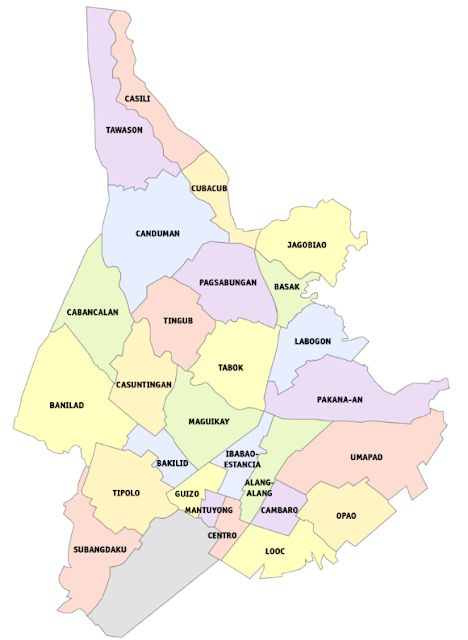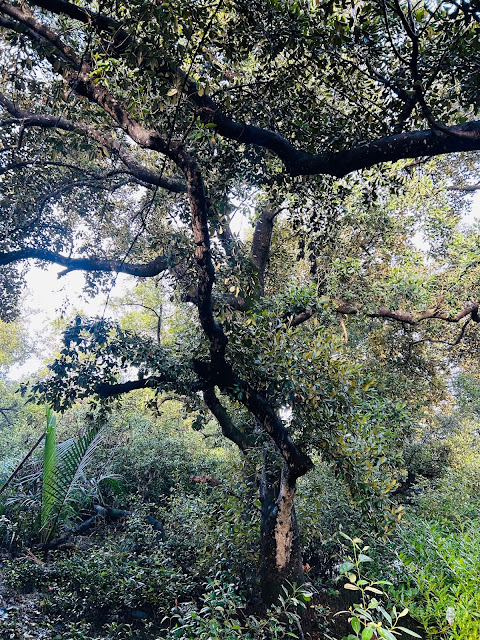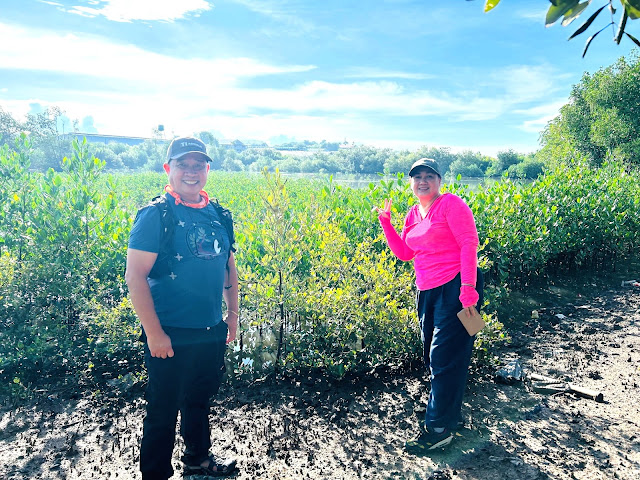Looking at the map of the Philippine archipelago, one can see that Cebu province is at the heart. It is the center of the Visayas, which in turn, Visayas is the middle of the Luzon-Visayas-Mindanao island groups. While "heart" can be interpreted metaphorically, Cebu's central location and significant role in trade, culture and tourism contribute to this perception that indeed Cebu is the heart. Being at the heart of the action, Cebu has grown to be one of the most populous provinces in the Philippines.
Cebu is the second most populous province in the country, following Metro Manila. According to the Philippine Statistics Authority, based on 2020 census, the population of the 9 cities and 44 municipalities located in Cebu province is 5,151,274. Of this total, 35% are accounted for by the highly urbanized cities (HUCs) - Cebu City (964,169), Lapu-Lapu City (497,604) and Mandaue City (364,116). Collectively, these three are known as the "tri-cities" of Metro Cebu.
Although the smallest of the HUCs of Cebu in terms of population and land area, Mandaue City is more densely populated than both Cebu City and Lapu-Lapu City. In fact, 2020 data from PSA shows that of the 17 HUCs outside Metro Manila, Mandaue City was the more densely populated with 14,461 persons per kilometer. Compare that to the population density of only 363 persons per kilometer at the national level.
HUCs like Mandaue City can be described as "concrete jungle" and "human zoo." While "concrete jungle" emphasizes the overwhelming presence of concrete, the "human zoo" analogy, popularized by zoologist Desmond Morris, focuses on the crowded living conditions experienced by city dwellers.
In this concrete jungle and human zoo environment, can mangroves thrive? In a highly urbanized city like Mandaue City, can a mangrove ecosytem flourish?
The Mangrove Loving Penguin (MLP) pondered these questions in mid-June as I was attending a business workshop in Seda Central Bloc Cebu. Given that I was already in Cebu province and this is a province that the MLP has not yet visited a mangrove forest, I decided to try and visit one in the locality during the weekend. I figured the nearest place for me to visit mangroves would be in the three cities of Metro Cebu. Looking at the map again, this time of Metro Cebu, I could see that there were patches of green in some coastal areas in Mandaue City and across the Lapu Lapu Cty.
 |
| Map of showing the distance from Ayala Malls Central Bloc to the green patches (possibly mangroves) in Mandaue City. |
Since I did not anymore wanted to cross the Mactan Channel to reach Lapu Lapu City, I decided that the more convenient place for me to visit mangroves would be in Mandaue City. But the thing is, I did not have any contact person for mangroves in Mandaue. I tried messaging the Mandaue City LGU but there were no response yet and Saturday was fast approaching. Good thing I chanced upon an ABS-CBN news article written by Annie Perez-Gallardo about the mangroves of Mandaue and the good people working together to protect them. The MLP immediately messaged the ABS-CBN regional correspondent and inquired for a contact person on Mandaue's mangroves. Quickly, she responded and suggested I touch base with Ms. Sharon Mangadlao, the OIC of theMandaue City Agriculturist Office. This I did and likewise, Ms. Sharon promply referred me to one of the officers in the MCAO - Lilibeth Barz.
Communication was established with Ms. Libeth late afternoon of June 20 and she granted my request to visit a mangrove forest in Mandaue City the following day. I would have been happy already with her granting my request to visit but I was even happier to know that she would be accompanying me in the visit. The following day was a Saturday and I would have undertood perfectly well if she would not have joined me as it was a weekend - a time for rest, a time for family. But bless my lucky star, Ms. Libeth is a hard working public servant and thanks to her and her staff, the MLP was able to visit mangroves in Mandaue on that Saturday morning.
Not only in 1 but in 3 coastal barangays was the MLP able to visit mangroves in Mandaue City.
 |
| Mandaue City has 9 coastal barangays of which 5 have significant mangrove areas. Umapad, Jagobiao, Basak, Labogon and Pakana-an. The MLP visited 3 of these 5. |
Mangroves of Brgy. Umupad: Mandaue dumpsite converted into an Eco-Park
To pursue environmental sustainability, the Mandaue City government led by Mayor Jonas Cortes back in 2014 started the development of the former dumpsite in Barangay Umupad into the Mandaue Green Learning Park. It was in this eco-park that the MLP met Ms. Libeth at 6am Saturday. Together with her was Rene Cobong, an officer of the Mandaue City Federation of Fisherfolks (MCFF). Both toured me inside the Mandaue Learning Park and gave more details about its origin and benefits to the community. The site is situated at the outfall of the Butuanon River which frequently overtops as a result of heavy rain and has been considered "biologically dead" since 1992.
 |
| Vicinity Map of Mandaue Green Learning Park in Brgy Umupad |
 |
| Entrance to the Mandaue Green Learning Park |
 |
| Site Development Plan of the Mandaue Green Learning Park |
 |
| MLP with Ms. Libeth Berz of the Mandaue City Agriculturist Office. At the back are Miapi mangroves (Avicennia marina). |
 |
| A passionate advocate for Mandaue's mangroves, Rene Cobong showing the Mandaue Mangrove Nursery inside the eco-park. |
Wow. From piles of trash to a green space of mangroves. From desolate to inspirational. Such a feel good story the Mandaue Green Learning Park is. From Brgy Umupad, Libeth and Rene ushered me to 2 more places in Mandaue City where mangroves are thriving. Will it have the same inspiring feel?
Mangroves of Brgy. Basak: Prisohan & Bakhawan
If Brgy Umupad is home to a newly-established eco-park, Brgy Basak is home to the new facility of the Mandaue City Jail. In mid-2023, more than a thousand Persons Deprived of Liberty (PDLs) were transferred from the old jail in Brgy Look to the new jail in Brgy Basak. High concrete walls surround the 1-hectare property of the new city jail, designed to contain inmates within the jail compound.
 |
| Vicinity map of the new Mandaue City Jail in Brgy Basak. |
 |
| Outside the Entrance Gate to the Mandaue City Jail. |
Outside the walls, particularly on the western part, is an old mangrove forest. These are the mangroves we first visited upon arrival in Brgy. Basak. The walls of the new Mandaue City Jail are tall, perhaps 20 to 25 feet tall but many of the mangroves outside the walls are taller. There are a good number of Avicennia rumphiana mangrove trees and the locals call it "Kalumpinay." The Avicennia rumphiana is one of the tallest mangroves sometime growing to 90 feet but it is usually much smaller than this. Some of the specimens in Brgy Basak I figured to be as tall as 40 feet and very old. A differentiating feature of the Avicennia rumphiana versus the more common Avicennia marina are its bark which is brown and rugged versus that of the latter which is smooth with thin flakes and greenish brown. The IUCN Red List of Threatened Species considers the Avicennia rumphiana as a vulnerable species, meaning it is facing a high risk of extinction in the wild. The Avicennia rumphiana is vulnerable because it has a patchy distribution, is uncommon in some areas, and is in general decline. Good thing, in this area of Brgy Basak, the Kalumpinay mangroves are still plentiful. But for how long?
 |
| Rene with his trusty celphone camera outside the walls of the Mandaue City Jail. A couple of mangrove trees seen towering over the wall. |
 |
| An old Kalumpinay mangrove tree (Avicennia rumphiana). Unlike Miapi mangrove (Avicennia marina) which has guava-like bark, the bark of the Kalumpinay is dark and rough. |
 |
| The Mandaue City LGU has passed Ordinance #15-2019-1485 declaring the entire mangrove area in Mandaue City as mangrove forest protected area. Violators beware. |
To the East of the new Mandaue City Jail are more marshes with a sitio community in between. To this area is where Libeth and Rene brought me which is still part of Brgy Basak. The name "Basak", afterall, is said to originate from the Cebuano word for "wet" and "swampy" reflecting the area's wetland nature. In the wetlands of Brgy Basak, the mangroves grow in abundance in very close proximity to the houses. The MLP saw batches of Miapi mangroves (Avicennia marina) and Bakhawan Babae mangroves (Rhizophora mucronata) in the marshes to the east of the Mandaue City Jail.
 |
| Libeth walking thru the narrow pathway of the sitio community to reach the mangrove forest area. |
 |
| Laden with its distinctive propagules, a Bakhawan Babae mangrove towering above other mangroves. |
 |
| The sitio in Brgy Basak is home to a number of fisherfolks who benefit from the mangroves. For one, a healthy mangrove ecosystem serves as crucial nursery habitat for many fish species. |
 |
| Recently planted Bakhawan Babae mangroves at a lot very near the new Mandaue City Jail. |
Observing the interaction of Ms. Libeth with the local residents as we passed thru the sitio to get to the mangroves, I can safely say that the Mandaue City Agriculturist Office is collaborating with the local residents in working together to protect and propagate the mangroves. As we exited the Brgy Basak area, a welcome sight for the MLP and all mangrove lovers out there was a sizeable lot (in google map, it looked bigger than the 1-hectare property of the city jail) recently planted with mangroves, mostly Bakhawan Babae. Looks like the collaborative pathway that the LGU and the local community are undertaking is bearing fruit.
Mangroves of Brgy. Jagobiao: Abandoned Fishponds & Renewed Hope for Mangroves
Based on a 2018 study commissioned by the LGU, Mandaue City has a total of 72 hectares of mangroves grouped into the South Patch (42 hectares) which is located along the coastline of Barangays Paknaan and Umupad and the North Patch (31 hectares) in Barangays Labogon, Basak and Jagobiao. The 3rd and last stop in my visit to the mangroves of Mandaue City is Barangay Jagobiao.
 |
| Vicinity map of the mangroves and fishponds in Brgy Jagobiao |
The community in the lowest lying zones of Brgy Jagobiao (and that of Brgy Basak) are prone to coastal flooding and storm surge. The hundreds of households in these areas experience regular coastal flooding of up to one meter during heavy rains. The majority of these households are fisherfolk or daily laborers, and with limited livelihood options, the majority of families live below the poverty threshold.
 |
| Very narrow pathway into the sitio community in Brgy Jagobiao. |
 |
| Some of the mangrove trees are almost right at the doorstep of the houses in Brgy Jagobiao. |
 |
| Bakhawan Babae mangroves ring the fishponds in the area. |
 |
| A fisherman checking on his catch in the fishpond |
The Mandaue LGU and other local stakeholders recognizes the importance of the restoration and management of the mangrove zone within which these families live within close and direct proximity. The need to conserve and preserve the mangroves is very important considering the threats of reclaiming them for urban land developments, and pollution and siltation from upland communities. That is why in the Climate Change Adaptation Framework (CCAF) adopted by the Mandaue City LGU a handful years back, among the resource mobilizations identified is the Community-based Protection and Rehabilitation of Mangroves. This is a resilient model that empowers the urban poor/fisherfolks and local stakeholders to work together. Among the key activities to be undertaken are establishment of a mangrove nursery in Brgy Jagobiao, training for mangrove propagation & nursery establishment, and livelihood development training. In my visit to Brgy. Jagobiao, I got to see up close the beginnings of a mangrove nursery which is located in an abandoned fishpond. In addition, the MLP was able to talk to a couple of community leaders who are knowledgeable and passionate about mangrove propagation and protection. There is hope for the mangroves and the community.
 |
| Reaching an abandoned fishpond which is being planted with mangroves by the community members |
 |
| Closely inspecting the growing mangroves which are a mix of Bakhawan Babae and Piapi. Most of the mangrove seedlings came from the mangrove nursery established in Brgy Jagobiao. |
 |
| Rene and another senior community leader looking hopefully at the young mangroves growing in the abandoned fishpond |
Three barangays with mangroves visited in Mandaue City on that Saturday morning. Happy to see mangroves thriving in the concrete jungle. Quite a blessing for the MLP and I have much to thank the duo of Libeth and Rene. Both are leaders in their own right. Both are hard working and taking the extra mile to achieve good results for the community despite all the challenges (real & present).
Speaking of leadership, Mandaue City is regarded as a model city for its progressive policies particularly in the areas of sustainability and resilience. In 2015, it was named as Asia Pacific Economic Cooperation (APEC) low carbon model town (LCMT), implementing the blueprint to promote low-carbon technologies to manage growing energy comsumption and mitigate the adverse effects of greenhouse gas emissions in the region. In 2024, Mandaue City was Top 3 under the Highly Urbanized City Classification of the Gawad Kalasag Seal and Special Awards for Excellence in Disaster Risk Reduction and Management and Humanitarian Assistance.
It is acknowledged among govt agencies and developmental NGOs that Mandaue City is one of the first cities in the Philippines that invested in an extensive process of community-based climate risk assessments that led to an in-depth undertanding of the critical impacts of climate change for communuties in the city, especially on their water resources and watersheds. In 2019, the Mandaue City LGU applied the CCAF approach in cooperation with members of the Mandaue Resilience Network which include the University of the Philippines Cebu Center for Environmental Informatics (UP Cebu CENVI), Catholic Organization for Relief and Development Aid (Cordaid), Philippine Red Cross Cebu Chapter, Wetlands International and other Civil Society Organizations in Mandaue City .
Good leadership are made possible by good leaders. Good leadership doesn't just happen; it's the result of individual men and women possessing key qualities and behaviors that enable them to make good things happen. Good leaders like the Mayor and other key officers of Mandaue City. Good leaders like the Sharon, Libeth and the good people in the Mandaue City Agriculturist Office. Good leaders like Rene and other community leaders on the ground.
Mabuhay ang Mandaue. Long live the mangroves of Mandaue City.







No comments:
Post a Comment